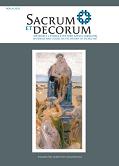Zapoznana pasja architekta Franciszka Mączyńskiego
The forgotten passion of Franciszek Mączyński, an architect
Author(s): Danuta Czapczyńska-KleszczyńskaSubject(s): Cultural history
Published by: Wydawnictwo Uniwersytetu Rzeszowskiego
Keywords: Franciszek Mączyński; stained glass; lead glass; Poland; 20th century; Krakowski Zakład Witrażów i Mozaiki S.G. Żeleński
Summary/Abstract: Franciszek Mączyński (1874–1947), a well-known architect, connoisseur and lover of ancient buildings, had an obvious penchant for designing stained glass through all of his professional life, which has remained relatively unnoticed by researchers, focusing on his work as an architect. Mączyński’s stained glass decorates sacred and secular buildings, sometimes also those designed by him. Many of them are lead-glass ones, made of colourless, semi-opaque glass with small multi-coloured plaques with coats of arms (the castle chapel in Żywiec, c. 1905) or most often with architectural motifs (predominantly towers, bell turrets and domes of Kraków churches, which were used by him for the first time around 1904 in the windows of the cloisters in the Convent of Discalced Carmelite Sisters at Łobzowska Street in Kraków). The polar opposite of these architectural miniatures is an exquisite stained-glass depiction of the wooden church at Komorowice Krakowskie, placed in the fanlight over the entrance to the new brick church in this village. Interesting lead-glass windows are used by the architect in the cloisters of the Franciscan Friary in Kraków, whose renovation he supervised (c. 1908). Mączyński was also familiar with figural compositions, as evidenced by the stained glass panels with the figures of saints at the church in Mogilany near Kraków and the Calced Carmelite Church in Kraków (1930). In the church stained glass Mączyński employed as well decorative and symbolic motifs (vases filled with flowers and fruits with hearts incorporated into them in the nave windows of the Jesuit Church at Kopernika Street in Kraków, 1912). The same theme, without symbolic overtones, was used by him later in stained glass intended for secular buildings. However, for his interior designs he preferred motifs from nature or architecture. Designing stained glass was not only Franciszek Mączyński’s passion, but also a hard work of many years as the Art Director of Krakowski Zakład Witrażów S.G. Żeleński. for which he also designed exhibition pavilions (among which the most interesting was the one for the Universal National Exhibition in Poznań in 1929).
Journal: Sacrum et Decorum. Materiały i studia z historii sztuki sakralnej
- Issue Year: 2010
- Issue No: 3
- Page Range: 143-164
- Page Count: 22
- Language: Polish

